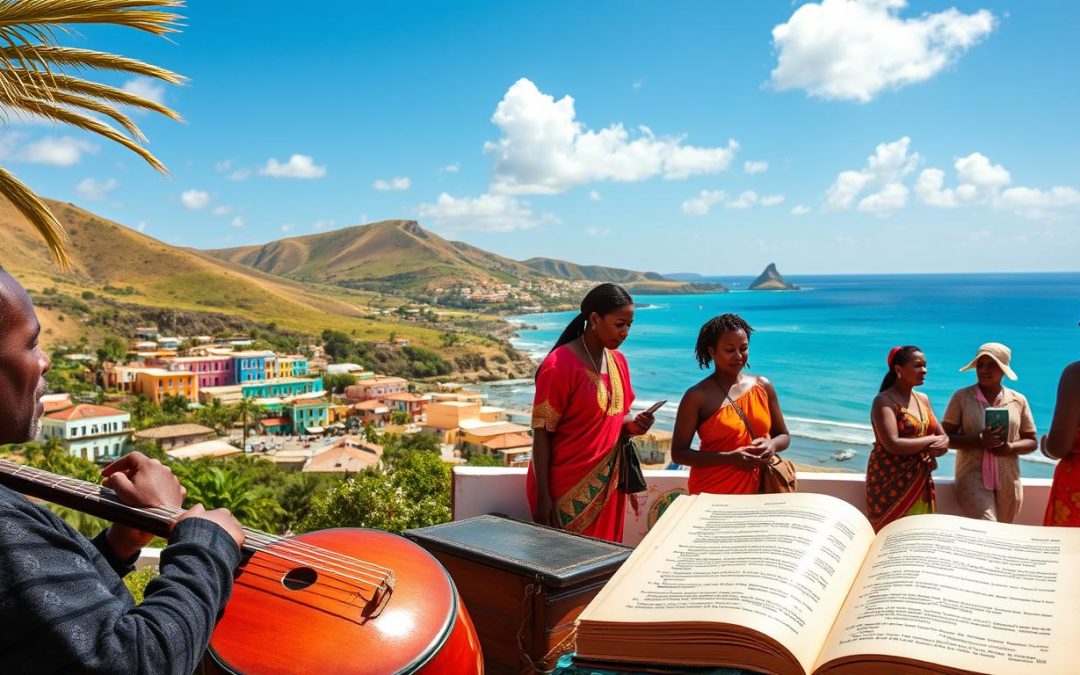Have you ever wondered how a small archipelago can preserve such a rich linguistic heritage? Cape Verde is a remarkable example of linguistic diversity. Here, languages tell a story of cultural resilience and historical transformation.
In Cape Verde, languages are more than just a way to communicate. They are living stories of identity. The official language, Portuguese, coexists with Cape Verdean Creole (Kriolu). Together, they create a unique linguistic ecosystem that reflects the nation’s complex history.
With about 90% of the population speaking Kriolu every day, this language is more than a dialect. It is the soul of Cape Verdean culture. It blends Portuguese structures with African influences.
Key Takeaways
- Portuguese is the official language of Cape Verde
- Cape Verdean Creole is spoken by nearly all residents
- Languages in Cape Verde reflect a rich cultural fusion
- Bilingualism is common among Cape Verdean adults
- Linguistic diversity represents historical resilience
Historical Development of Languages in Cape Verde
The story of languages in Cape Verde is rich and complex. Portuguese explorers arrived in 1462, finding empty islands. These islands would soon mix languages, thanks to colonial history and slavery.
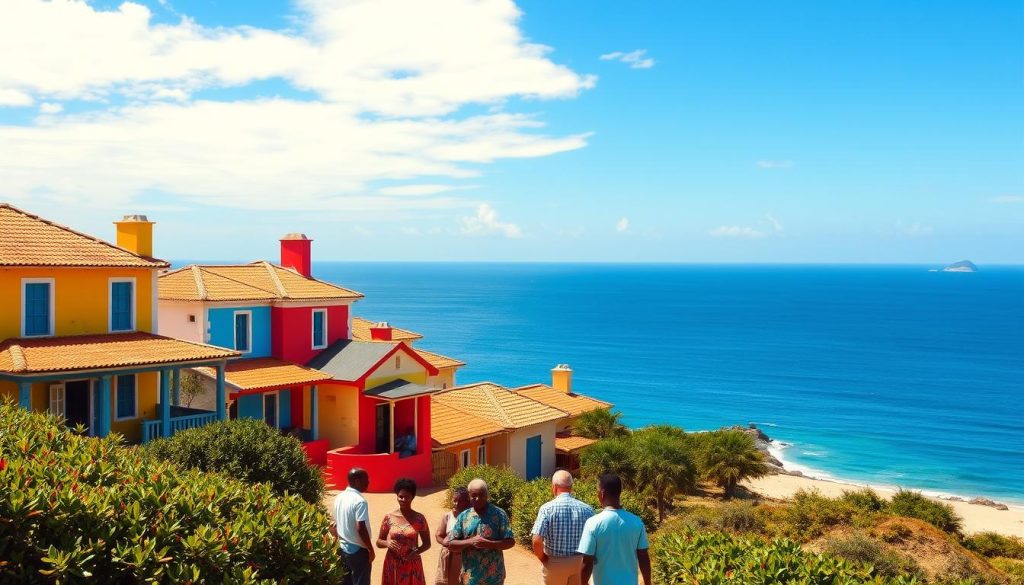
To understand Portuguese in Cape Verde, we must look at its colonial roots. The Portuguese brought their language and culture. This changed how people communicated in the archipelago.
Portuguese Colonial Linguistic Impact
The Portuguese greatly changed language use. Key points include:
- Introduction of Portuguese as the official language
- Setting up formal communication systems
- Creating schools that used Portuguese
Evolution of Local Languages
As Portuguese and African slaves interacted, a Creole language emerged. This Creole was more than just a way to talk. It showed cultural strength and identity.
“Language is the roadmap of a culture. It tells you where its people come from and where they are going.” – Rita Mae Brown
Impact of Slavery on Linguistic Development
The slave trade greatly increased language variety in Cape Verde. Slaves from West Africa brought their languages. These mixed with Portuguese, creating Cape Verdean Creole.
By the 16th century, Santiago island was key in the slave trade. This made the mix of languages even more complex, shaping Cape Verde’s future.
Portuguese as the Official Language of Cape Verde
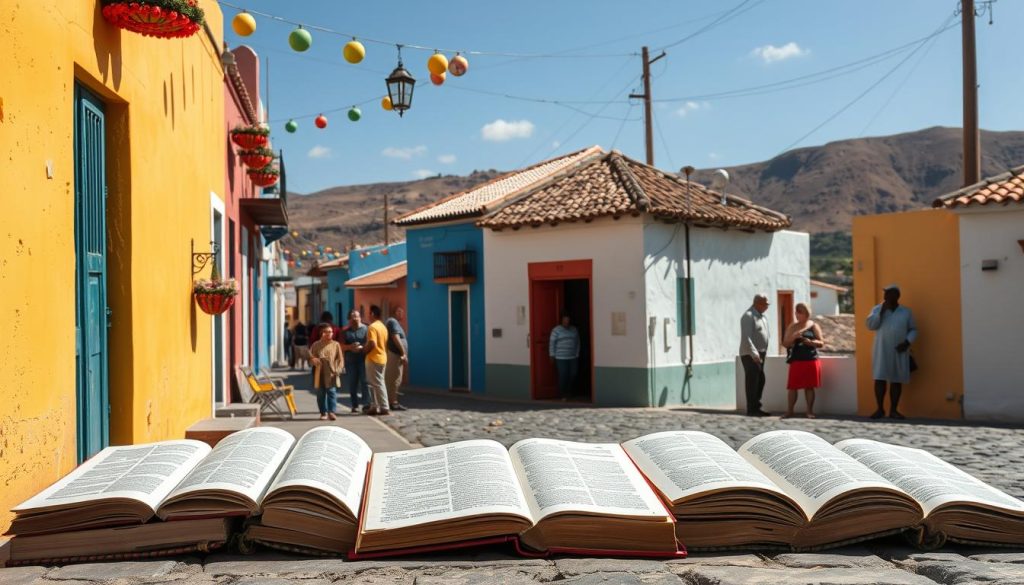
In Cape Verde, Portuguese is key for official talks. It’s a big part of the country’s culture. It’s used in government, schools, and media.
Keeping Portuguese as an official language shows Cape Verde’s ties to Portugal. It helps the country stay connected to the world while keeping its own identity.
“Language is the road map of a culture. It tells you where its people come from and where they are going.” – Rita Mae Brown
Portuguese is important in many areas:
- Government administration
- Judicial proceedings
- Educational instruction
- National media broadcasting
- Diplomatic communications
Here are some interesting facts about Portuguese in Cape Verde:
| Language Domain | Percentage of Usage |
|---|---|
| Official Government Communication | 100% |
| Educational Instruction | 95% |
| Media Broadcasting | 90% |
| Population Speaking Portuguese | 10% |
Even though only 10% speak it first, Portuguese is the main language. It brings people together. It helps Cape Verde stay connected globally while celebrating its culture.
Cape Verdean Creole (Kriolu): The People’s Voice
Kriolu is at the core of Cape Verde’s culture. It’s a vibrant language born from the mix of Portuguese and African tongues. This creole language shows the rich heritage of the islands.
Origins and Linguistic Roots
Kriolu came to life during the colonial era. It was a way for Portuguese settlers and enslaved Africans to talk. Its story is one of cultural blending and survival.
- It mixes Portuguese grammar with African words.
- By 2017, 871,000 people spoke it as their first language.
- It’s the main language for almost all Cape Verdeans.
Regional Variations
Kriolu shows a lot of diversity across Cape Verde’s islands. There are two main dialect groups:
| Dialect Group | Islands | Characteristics |
|---|---|---|
| Barlavento Creoles | Boa Vista, Sal, Santo Antão, São Nicolau, São Vicente | Northern dialect variations |
| Sotavento Creoles | Brava, Fogo, Maio, Santiago | Southern dialect variations |
Cultural Significance
Kriolu is more than just a way to talk. It’s a symbol of national pride. Its role in literature and art shows its deep cultural value in Cape Verde.
Kriolu is not just a language, but the soul of Cape Verdean cultural expression.
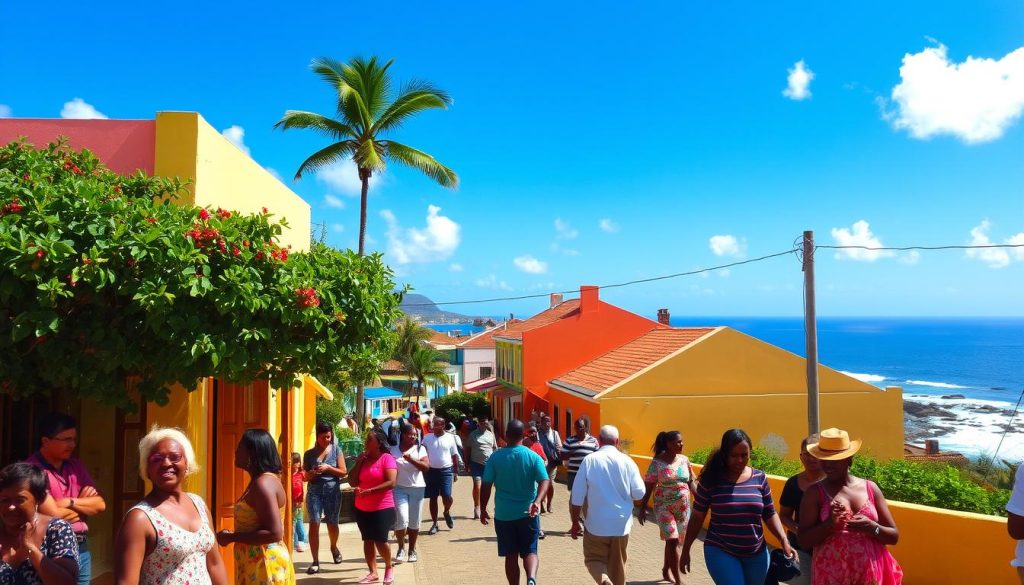
The language is growing in importance. It’s getting more respect in schools and government. Its journey from a simple way to communicate to a respected language shows Cape Verde’s strength and pride.
Dialectal Differences Across the Islands
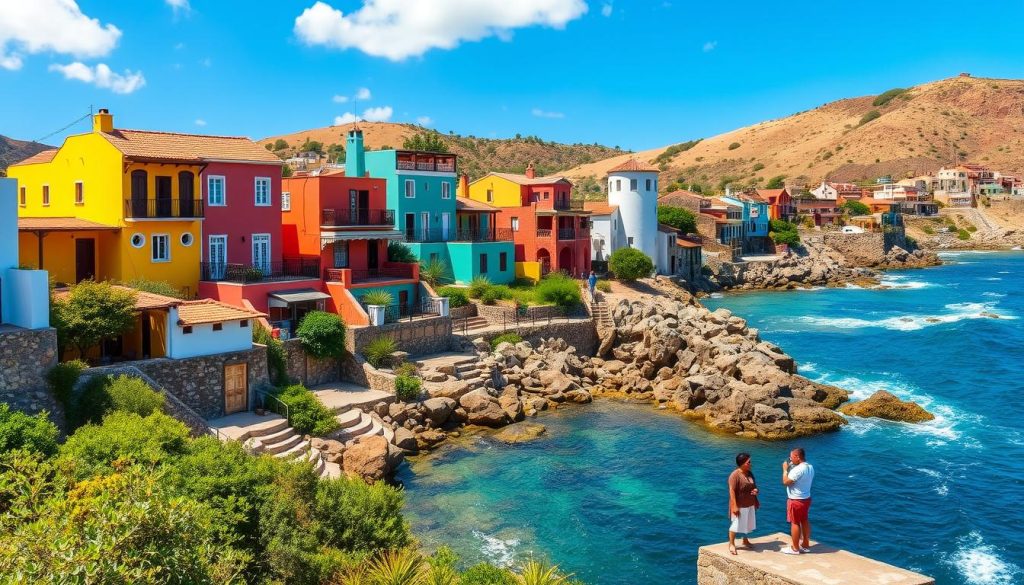
Exploring the Cape Verde archipelago reveals a world of linguistic diversity. Each of the nine inhabited islands has its own unique dialect of Cape Verdean Creole (Kriolu). This creates a rich tapestry of multilingualism that shows the archipelago’s complex cultural heritage.
The linguistic landscape of Cape Verde is divided into two main dialect groups:
- Barlavento Creoles: Spoken in the northern islands
- Sotavento Creoles: Predominant in the southern islands
These dialects come from different historical and cultural influences. For example, São Vicente Creole is a key part of Barlavento’s linguistic identity. On the other hand, Santiago Creole represents the Sotavento tradition. Experts have long discussed the idea of standardizing these dialects.
“Language is the roadmap of a culture. It tells you where its people come from and where they are going.” – Rita Mae Brown
Cabo Verdean culture is deeply connected to these linguistic nuances. With about 1.2 million native speakers, Kriolu variations show the archipelago’s rich history. They highlight how language changes through social interactions, migration, and cultural exchanges.
Despite the differences, a remarkable 84.3% of Cape Verdeans can read and write in Portuguese while speaking Kriolu. This shows the island nation’s remarkable linguistic adaptability.
Language Distribution Demographics
Cape Verde’s language scene is a colorful mix of many tongues. With 596,707 people, it shows how languages blend due to history and culture.
About 70% of the people are mixed-race. This mix creates a special place where languages meet and change.
- Portuguese is the official language, spoken by over 500,000.
- Cape Verdean Creole (Kriolu) is the main language at home.
- In cities like Praia, more people speak Portuguese.
- In the countryside, Kriolu is the main language.
Younger people in Cape Verde often speak both Portuguese and Kriolu. This shows how language policies are changing.
“Language is the roadmap of a culture. It tells you where its people come from and where they are going.” – Rita Mae Brown
The biggest islands have their own language patterns:
- Santiago (269,370 people): Most Kriolu speakers.
- São Vicente (74,016 residents): Balanced use of Portuguese and Kriolu.
- Santo Antão (36,632 people): Strong focus on local language.
Knowing about these language patterns helps us see Cape Verde’s rich culture and how people communicate.
Language in Education and Public Life
In Cape Verde, the Portuguese language is key in schools and public places. It’s the main language used in teaching and talking. This shows the country’s ties to its colonial past.
The language rules in Cape Verde are special. Portuguese is the official language, but Cabo Verdean Creole (Kriolu) is very important too. The national constitution aims to make Kriolu more recognized, honoring its place in local culture.
- Portuguese is used in formal educational settings
- Creole language dominates informal communication
- Government documents are primarily in Portuguese
- Media broadcasts utilize both languages
Literacy rates show how well language education works in Cape Verde. Men and women both have high literacy rates. This shows the country’s focus on teaching and learning.
“Language is the roadmap of a culture. It tells you where its people come from and where they are going.” – Rita Mae Brown
| Language Domain | Primary Language | Secondary Language |
|---|---|---|
| Government | Portuguese | Kriolu |
| Education | Portuguese | Kriolu |
| Media | Portuguese | Kriolu |
The talk about language is always changing in Cape Verde. As the country grows, so do its language rules. It’s a balance between honoring Portuguese and celebrating Creole.
Modern Language Trends and English Influence
Cape Verde’s language scene is changing fast in the digital world. The islands are seeing a big shift in how people talk, thanks to the internet and global connections.
English is becoming more popular in Cape Verde, changing how people talk in many areas. Knowing about these changes helps us understand the country’s growing use of many languages.
Tourism’s Linguistic Impact
Tourism is playing a big role in changing languages in Cape Verde. Visitors from around the world are making English more common, especially in:
- Coastal resort areas
- Hotel and hospitality sectors
- Tourist information centers
International Business Communication
As Cape Verde connects more with the world, English is becoming key for business. People are using English more for:
- Multinational corporate interactions
- Foreign investment negotiations
- Global trade communications
Digital Communication Dynamics
The internet is changing how languages are used and understood. Young people in Cape Verde are learning English through:
- Social media engagement
- Online educational resources
- Global digital networking
“Language is the road map of a culture. It tells you where its people come from and where they are going.” – Rita Mae Brown
| Language Domain | English Influence Level | Primary Communication Context |
|---|---|---|
| Tourism | High | International Visitor Interactions |
| Business | Medium-High | Corporate Communications |
| Digital Media | High | Global Networking |
As Cape Verde joins the global community, English is becoming a key language. It’s changing how people communicate in different parts of society.
Cultural Identity Through Language
Language is at the heart of Cabo Verdean culture. It brings together the diverse languages that make up the archipelago. Cape Verdean Creole (Kriolu) is more than a way to talk. It shows the nation’s pride and identity.
The languages of Cabo Verde mix African tongues with Portuguese. Kriolu is the main language, spoken by almost everyone. It shows how language and culture are deeply connected.
- Kriolu represents the linguistic soul of Cabo Verde
- Two primary dialect groups: Barlavento and Sotavento
- Significant regional variations across different islands
Writers like Eugénio Tavares and Germano Almeida have made Kriolu a powerful tool for art. Their stories show the language’s ability to express the feelings and lives of Cape Verdeans.
“Language is the road map of a culture. It tells you where its people come from and where they are going.” – Rita Mae Brown
| Language Aspect | Cultural Significance |
|---|---|
| Kriolu Usage | Primary communication method |
| Diaspora Preservation | Maintaining cultural connections |
| Literary Expression | Capturing national identity |
The Cape Verdean diaspora is key in keeping this language alive. In the United States, Kriolu keeps families connected, even when they’re far apart.
Conclusion
Your journey through Cape Verde’s linguistic world shows a rich mix of communication. This mix reflects the nation’s complex history. Portuguese is the official language, while Cape Verdean Creole (Kriolu) is the heart of daily talk.
The language diversity in Cape Verde is more than just talking. Each of the nine Creole variants shares stories of island identity. Speakers across different areas keep understanding each other. English is also present, especially for tourists, but Portuguese and Creole are more central to the culture.
Exploring language in Cape Verde shows it’s not just for talking. It’s a living proof of the country’s history. From the windward islands to the sotavento regions, the language shows a culture that has turned colonial influences into something vibrant and unique.
As Cape Verde looks to the future, its languages are a strong symbol of national identity. Whether you see official documents in Portuguese or hear Creole in local areas, you’ll see a language landscape that’s both traditional and modern.
The above is subject to change.
Check back often to TRAVEL.COM for the latest travel tips and deals.
Here are some Tours & Sightseeing suggestions that might pique your interests!
